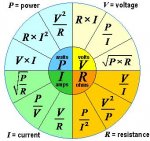Your circuit doesn't "break" the P=IV equation. Other parts of your statements are confusing, or indicative of confusion on your part. You are seeming to conflate phase angle with voltage / power. Voltage and power doesn't give a rat's butt what the phase angle is, 120, 180 etc., irrelevant.
What IS relevant is the nature of this LOAD. Not all loads are created equal. The P=IV equation is only true for purely resistive loads. P (power, as in watts) is actually I x V x PF (Power Factor), but with a purely resistive load, the PF = 1, so it becomes irrelevant and is often left out. But if the load is in any way inductive, then the PF is no longer irrelevant. But that doesn't address your question.
Looking at just the purely resistive load in order to fit with your question, there is another mitigating factor, the Resistance, R. Yes, P = IV, but I and V are influenced by R, in that I = V/R, and V = I x R. If you change the V on your load that is purely R, and assuming the load remains at the the SAME value of R, then P = V
2 x R, meaning the P actually
increases, just not as a direct 1:1 ratio of the increase in V. I will also increase, because I = V/R.
This by the way is why Ohm's law is often depicted as a "wheel". You really can't change one thing without considering the effects of the others.
View attachment 21383

